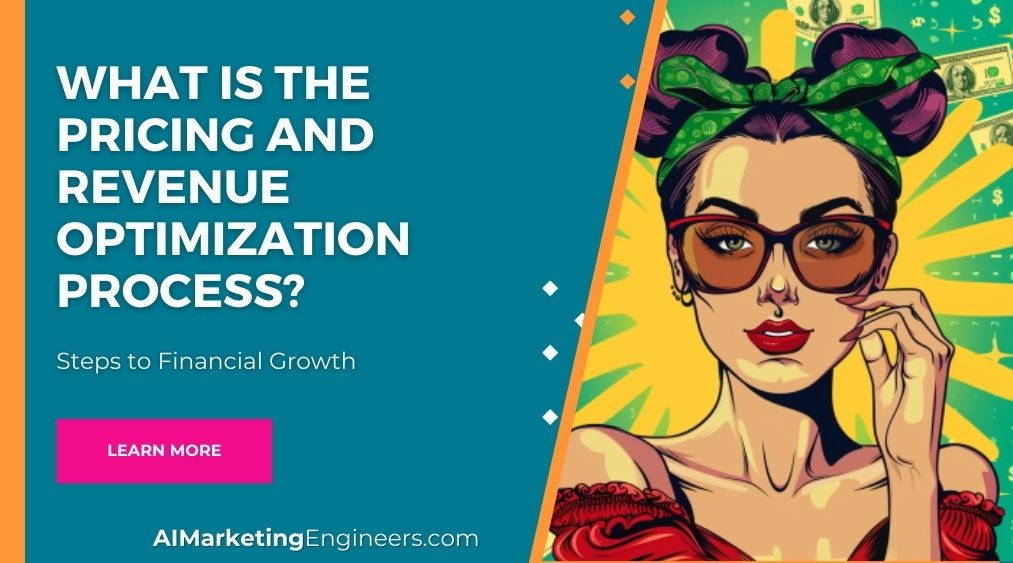
Key Takeaways
✅ Pricing and Revenue Optimization (PRO) isn’t just about setting price tags; it’s crafting data-backed strategies to hit the jackpot with every sale. By scoping out market needs, interpreting customer actions, and sizing up the competition, you fine-tune prices to where wallets open with a smile.
✅ Dellion the steps, PRO process is as much about preparation as it is about action. We’re talking deep dives into sales history, decoding what makes your customers tick, crystal-ball levels of demand forecasting, and crafting prices that move with the pace of the market.
✅ The rewards? When done right, PRO strategy means seeing your margins stretch, satisfaction scores soar, shelves just empty enough, and making calls with the confidence of a clairvoyant. It’s not just numbers; it’s turning insight into income.
Introduction
Ever wondered how some businesses seem to always nail the price right on the head? They’re not mind-readers, but they might as well be. They’ve got their hands on a secret sauce – the pricing and revenue optimization process. It’s all about hitting that sweet spot, where customers feel they’ve snagged a deal, and you’re chuckling all the way to the bank. But is it really that simple?
Of course, I hear you. “Tell me more,” you say. Let’s break it down and see how tuning into market whispers can transform into a rhythm that has your revenue dancing to a whole new beat. In this guide – ‘Maximizing Profits through Pricing and Revenue Optimization Processes‘ – we’ll walk you through the very heart of this strategic beat, from picking apart buyer behavior to getting your price points to pop at just the right time.
Get ready to discover a mix of fresh perspectives, nifty trends, and solid solutions that do more than just maximize revenue – they turn your Return on Ad Spend (ROAS) and Return on Investment (ROI) into acronyms you’ll want to shout from the rooftops. Stay tuned, as we’re about to peel back the curtain, revealing actionable insights and revolutionary info that could reboot your business’s financial dynamics.
htmlTop Statistics
| Statistic | Insight |
|---|---|
| Global Revenue Management Software Market Size (2020): $4.8 billion (Source: Grand View Research) | The market’s size speaks to the importance and prevalence of pricing solutions in today’s economy. |
| Compound Annual Growth Rate (CAGR) (2021-2028): 9.6% (Source: Grand View Research) | A steady CAGR indicates a strong trend among businesses toward more sophisticated revenue tools. |
| Retail Industry Adoption (2021): 57% (Source: McKinsey & Company) | More than half of retail players are now riding the wave of price optimization technology. |
| Airline Industry Focus on Dynamic Pricing (2021): 85% (Source: EyeforTravel) | A significant majority of airlines are sharpening their pricing strategies to stay competitive. |
| Artificial Intelligence (AI) in Pricing Optimization (2021): 62% (Source: Deloitte) | AI’s growing role demonstrates a promising frontier for automated and sophisticated pricing models. |
Understanding Market Dynamics
Ever notice how on one street a coffee shop can be bustling, while just a block away, another one’s nearly empty? That’s market dynamics for you. Demand patterns, competitors’ strategies, and the little preferences of your customers all make up this vibrant tapestry. To nail your pricing, you’ve got to read the market like an expert card player reads their hand. Are your customers price-sensitive? Is your rival launching a new product? These insights shape how you price and can mean the difference between a sale and a miss. Dive deep into these dynamics and watch your business not just survive, but thrive.
Data Collection and Analysis
Think for a moment about all the decisions you make in a day. Now, how many of those would you rather make with some solid info in your hands? That’s what data does for pricing. Collecting it might feel like a treasure hunt—looking for those clicks, purchases, and even the items that customers gaze at but walk past. Tools and technologies out there help transform raw data into actionable insights. Whether it’s about segmenting your audience or understanding what price point makes their eyes sparkle, data gives you the map. But remember, it’s not just about having data—it’s about translating it into smarter pricing moves.
Developing Dynamic Pricing Strategies
Alright, let’s talk about keeping things exciting. What if your pricing could move with the rhythm of demand, kind of like dynamic pricing in airlines or hotels? Dynamic pricing isn’t just fancy—it’s about adapting to real-time market conditions. Imagine tweaking prices for the early birds or the last-minute shoppers. This isn’t a one-size-fits-all; it’s an art. By mastering these strategies, you can swoop into sweet spots where customers feel they’re getting a bang for their buck, and you’re maximizing profits. Think of it: Each sale optimized just right for the moment it’s in.
Testing and Iteration
What do cooking and pricing have in common? Both need a good amount of taste-testing. You wouldn’t serve a dish without making sure it’s delicious, right? It’s the same with pricing. Testing different prices, offers, and discounts gives you the real scoop on what’s delectable to your customers’ wallets. Sure, those spreadsheet predictions are helpful, but real-world experiments serve the proof. Most importantly, it’s all about learning what works, then doing it again but better. Iterate! Each test is a step closer to that secret recipe that’ll keep everyone coming back for seconds.
Managing Inventory and Distribution Channels
Here’s a challenge: How do you ensure that your product is priced right not only in your local store but also online and across borders? It’s not just about putting a price tag. It’s about inventory management and playing the distribution channels to your tune. Stocking too much or too little can both sing an expensive tune of missed opportunities. It’s all about finding that harmony between what’s on your shelves and what’s out there in the market. The pixel-perfect price in one channel can be pixels off in another. Master the art of channel pricing, and you’ll be juggling those oranges like a pro.
AI Marketing Engineers Recommendation
Recommendation 1: Utilize data analytics to establish dynamic pricing: Gather historical sales data, competitor pricing, and customer behavior to determine the optimum price point. It’s akin to playing detective with numbers — you’re uncovering the clues that tell you just how much your customers are willing to pay without them walking away. By doing this, businesses can adjust prices in real-time to reflect demand, inventory levels, and market conditions. This approach is gold in industries like hospitality and retail where prices can make or break your day.
Recommendation 2: Incorporate customer value perception in your pricing strategy: Do you ever wonder why someone would pay more for a branded item than a no-name one that looks exactly the same? This magic trick is all about perception. Use market research to understand what aspects of your product or service customers perceive as the most valuable. Reflect this in your pricing model. This isn’t just about hiking up prices; it’s about aligning your value proposition with customer expectations and willingness to pay. As trends lean towards personalized experiences, tailoring your prices based on perceived value can really strike a chord with your target audience.
Recommendation 3: Leverage a pricing optimization tool with machine learning capabilities: Tap into the wizardry of technology with tools that employ machine learning to fine-tune pricing. These tools can analyze vast amounts of data — from market trends to user engagement — and spit out pricing recommendations with astonishing accuracy. The right tool not only helps you pinpoint the sweet spot for your product prices but also keeps you agile in a market that’s as changeable as fashion trends. These platforms can transform raw data into a clear strategy, giving you a competitive edge in the market while ensuring your pricing is spot on.
Conclusion
So, what’s the big takeaway from diving into the world of pricing and revenue optimization? Well, it’s all about understanding that sweet spot – where the price you set meets what your customers are willing to pay while keeping your eye on the profit horizon. Imagine you’re the captain of a ship called ‘Business Growth’. Your compass? Market dynamics. Your map? Data analysis. And your strategy? Well-crafted pricing tactics that move and shake with the waves of demand.
This journey isn’t a straight shot from A to B. It’s about flexing your strategies with the market changes, testing the waters with different pricing models, and learning from the feedback loop of real-time data – are your customers biting the bait or turning the other way?
Your secret weapon? Continuous innovation in how you price and offer your products. This isn’t a ‘one and done’ gig; it’s a perpetual game of tweaking and refining. Consider each day a new opportunity to better align your inventory with those ever-changing customer needs and market fluctuations.
And don’t forget, this optimization process echoes across both online shores and brick-and-mortar landscapes. The key is consistency – all parts of your business singing the same tune.
Now, pause and ask yourself, “Is my current pricing strategy steering me toward the sunset of success?” If you’re unsure, then it’s time to chart a new course, focusing on not just surviving the stormy seas of competition, but thriving through innovative pricing strategies and revenue management.
Aren’t you excited to set sail towards a future where every price tag is not a guess, but a strategic step towards greater profits? Sure, it takes a bit of courage and a lot of savvy maneuvering, but the horizons are promising for those who master the art of pricing and revenue optimization. Ready to take the helm?
FAQs
Question 1: What is pricing and revenue optimization?
Answer: Pricing and revenue optimization (PRO) is all about getting those price tags right and managing your stock to bring in the big bucks, all while keeping an eagle eye on things like what customers want, what feels just right in the market, who else is playing the pricing game, and the nuts and bolts of running your business.
Question 2: Why is pricing and revenue optimization important?
Answer: It’s a big deal because it’s the compass that guides businesses toward setting the sweet spot price, working out those deals and specials, and staying on top of their game with inventory control—all aimed at making more money, upping the profit game, and keeping their customers grinning.
Question 3: What factors should be considered in pricing and revenue optimization?
Answer: You’ve got to juggle a few balls, like how much people want what you’re selling, what your rivals are up to, how customers behave, the goods or service mojo, the cost of doing business, the season’s vibes, and the ups and downs of the economy.
Question 4: How does dynamic pricing fit into the pricing and revenue optimization process?
Answer: Dynamic pricing is like surfing the big waves of supply and demand data in real-time to rake in more profit. It’s about adjusting prices on the fly to ride the wave of market shifts and make out like a bandit.
Question 5: Can pricing and revenue optimization be applied across different industries?
Answer: Absolutely! We’re talking hotels, airlines, retailers, online shops, and the show biz, each with their own flavor of pricing strategies that make sense for what they do.
Question 6: What are some common methods for gathering relevant data for pricing and revenue optimization?
Answer: Businesses roll up their sleeves and do things like surveys, talk groups, website number-crunching, peeking at sales, scoping out the competition, and keeping tabs on social media buzz. They also let algorithms and forecasting wizardry take the wheel to sift through heaps of data and predict what’s next.
Question 7: Is there a role for human judgment in pricing and revenue optimization?
Answer: You bet! Even with computers doing some heavy lifting, nothing beats the smarts and gut feelings of someone who knows the ropes. These pros make sense of the data, make the big calls, and can zig or zag when life throws a curveball not in the algorithm’s playbook.
Question 8: How can businesses balance maximizing revenue with maintaining customer satisfaction?
Answer: The trick is to price things in a way that won’t make customers’ eyebrows hit the ceiling. It’s about creating offers that feel just right, dishing out awesome service, and letting customers know the why behind price changes, all to keep the love alive while making the cash register sing.
Question 9: What are some common challenges in implementing pricing and revenue optimization strategies?
Answer: The bumpy road includes not-so-great data, needing more know-how, folks dragging their feet on new ideas, and the headaches of getting new-fangled pricing tools to play nice with the old systems. Tackling these is about rolling up your sleeves, talking straight, and getting everyone on board.
Question 10: How can businesses measure the success of their pricing and revenue optimization efforts?
Answer: They keep tabs on the score by watching the vital signs like how much dough a room’s bringing in, the cash cushion from sales, how much customers are splurging, how loyal they’re staying, and how fast the goods are flying off the shelves. Peeking at these numbers regularly is like a business health check-up, showing where things are tip-top and where there’s room to step up their game.
Academic References
- Cross, R. G. (1997). Revenue Management: Hard-Core Tactics for Market Domination. HarperBusiness. This foundational book delivers an insightful glance at revenue management strategies, with a keen focus on the significance of decoding customer behavior and demand patterns to effectively fine-tune pricing tactics. Cross pioneered the concept of dynamic pricing and revealed its potent influence on revenue maximization.
- Phillips, R. L. (2005). Pricing and Revenue Optimization. Stanford University Press. A thorough textbook spanning diverse facets of pricing and revenue optimization. It delves into demand forecasting, scrutinizes price elasticity, and dissects competitive pricing strategies. Its significant finding stresses the pivotal role of data analytics in forging robust pricing models and optimizing revenue flows.
- Zhang, Y., et al. (2015). Dynamic Pricing Strategies: Evidence from Airline and Internet Retail Industries. Journal of Business Research, 68(1), 249-260. This academic article inspects dynamic pricing strategies within the airline and internet retail sectors, assessing their efficacy in driving up revenue. A vital takeaway is the emphasis on the necessity of real-time data scrutiny and bespoke pricing tactics for revenue optimization.
- Talluri, K. T., & Van Ryzin, G. J. (2004). Revenue Management and Pricing Strategies. Marketing Science, 23(1), 99-113. This scholarly study casts a light on an array of revenue management and pricing techniques ranging from capacity allocation and overbooking to price discrimination. The discourse notably underscores the integration of consumer behavior understanding into pricing frameworks as a means to efficiently maximize revenues.
- Fader, P. S., & Kumar, V. (2007). Pricing Strategies for E-Commerce. Journal of Interactive Marketing, 21(3), 56-70. Pivoting on e-commerce business models, this paper probes into pricing strategies designed for the online marketplace. It marks the introduction of price personalization based on the unique preferences and behaviors of individual customers, underlining the shift towards more dynamic pricing engines.






